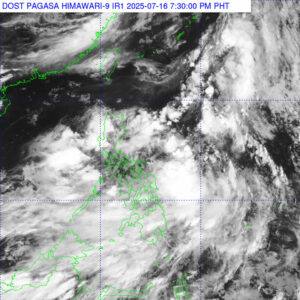A LOW-PRESSURE area east of Catanduanes has developed into a tropical depression, according to the state weather bureau.
The tropical depression that authorities named Crising may intensify into a tropical storm by Thursday morning, the Philippine Atmospheric, Geophysical and Astronomical Services Administration (PAGASA) said on Wednesday. It could reach the severe tropical storm category by Friday, it added.
Crising was spotted 625 kilometers east of Virac town in Catanduanes as of 4 p.m., the agency said in a 5 p.m. report.
It was moving westward at 20 kilometers per hour (kph), packing maximum sustained winds of 45 kph near the center, gustiness of up to 55 kph and central pressure of 1002 hectopascals.
“Strong winds extend outwards up to 280 km from the center,” PAGASA said.
It said tropical cyclone wind signal No. 1 might be hoisted over portions of Cagayan Valley by Wednesday evening or early Thursday morning.
“Should Crising maintain its westward movement or increase its radius, the possibility of raising tropical cyclone wind signal No. 1 over Catanduanes is also not ruled out,” it said. “Furthermore, the highest wind signal which may be hoisted during the occurrence of Crising is wind signal No. 3 or 4.”
Earlier in the day, PAGASA said Crising was forecast to move west-northwestward throughout the forecast period. It was expected to be closest to northern Luzon by Friday evening.
“It is forecast to continue intensifying over the Philippine Sea and may reach severe tropical storm category by Friday afternoon or evening, prior to its approach to the northern Luzon area.”
PAGASA said Crising’s development into a typhoon category “prior to approach is not ruled out.”
Crising may pass close to or make landfall over the Babuyan Islands, while a “slight change in the succeeding forecast track may also suggest a landfall scenario over mainland Cagayan.”
The Philippines lies along the typhoon belt in the Pacific and experiences about 20 storms each year. It also lies in the so-called Pacific Ring of Fire, a belt of volcanoes around the Pacific Ocean where most of the world’s earthquakes strike.
The Southeast Asian nation constantly experiences unavoidable losses and damage equivalent to 0.5% of its annual economic output mainly due to an increasingly unpredictable climate, according to the Finance department. — KATA
